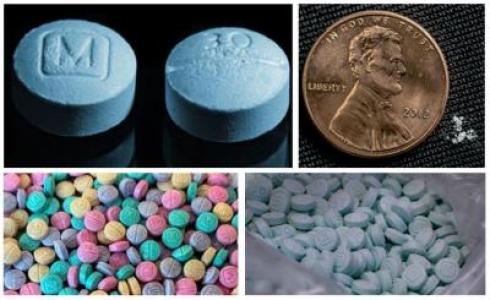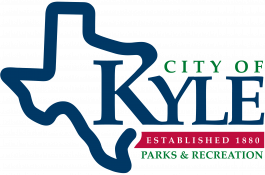Fentanyl Awareness
Quick Links:
- What is Fentanyl?
- Fentanyl and Overdose
- What is the effect on the body?
- Signs of Overdose
- What to do if you think someone is overdosing
- What is Naloxone?
- Substance Abuse and Mental Health Resources
- Other Resources
- In the News
What is Fentanyl?
 Fentanyl is a synthetic opioid that is up to 50 times stronger than heroin and 100 times stronger than morphine. It is a major contributor to fatal and nonfatal overdoses in the U.S.
Fentanyl is a synthetic opioid that is up to 50 times stronger than heroin and 100 times stronger than morphine. It is a major contributor to fatal and nonfatal overdoses in the U.S.
There are two types of fentanyl: pharmaceutical fentanyl and illicitly manufactured fentanyl. Both are considered synthetic opioids. Pharmaceutical fentanyl is prescribed by doctors to treat severe pain, especially after surgery and for advanced-stage cancer.
However, most recent cases of fentanyl-related overdose are linked to illicitly manufactured fentanyl, which is distributed through illegal drug markets for its heroin-like effect. It is often added to other drugs because of its extreme potency, which makes drugs cheaper, more powerful, more addictive, and more dangerous.
Fentanyl and Overdose
Fentanyl and other synthetic opioids are the most common drugs involved in overdose deaths.1 Even in small doses, it can be deadly. Over 150 people die every day from overdoses related to synthetic opioids like fentanyl.
Drugs may contain deadly levels of fentanyl, and you wouldn’t be able to see it, taste it, or smell it. It is nearly impossible to tell if drugs have been laced with fentanyl unless you test your drugs with fentanyl test strips.
Test strips are inexpensive and typically give results within 5 minutes, which can be the difference between life or death. Even if the test is negative, take caution as test strips might not detect more potent fentanyl-like drugs, like carfentanil.
What is the effect on the body?
Fentanyl, similar to other commonly used opioid analgesics (e.g., morphine), produces effects such as relaxation, euphoria, pain relief, sedation, confusion, drowsiness, dizziness, nausea, vomiting, urinary retention, pupillary constriction, and respiratory depression.
Recognizing the signs of opioid overdose can save a life. Here are some things to look for:
- Small, constricted “pinpoint pupils”
- Falling asleep or losing consciousness
- Slow, weak, or no breathing
- Choking or gurgling sounds
- Limp body
- Cold and/or clammy skin
- Discolored skin (especially in lips and nails)
What to do if you think someone is overdosing
- Call 911 immediately.
- Administer naloxone, if available.
- Try to keep the person awake and breathing.
- Lay the person on their side to prevent choking.
- Stay with them until emergency works arrive.
What is Naloxone?
Naloxone is a life-saving medication that can reverse an overdose from opioids—including heroin, fentanyl, and prescription opioid medications—when given in time. Naloxone is easy to use and small to carry. There are two forms of naloxone that anyone can use without medical training or authorization: prefilled nasal spray and injectable. Naloxone is available in all 50 states. If you have been prescribed high-dose opioids, talk to your doctor about co-prescribing naloxone. However, in most states, you can get naloxone at your local pharmacy without a prescription. You can also get naloxone from community-based naloxone programs and most syringe services programs.
Substance Abuse and Mental Health Resources
- Substance Abuse and Mental Health Services Administration (SAMHSA):
- 24/7 National Hotline: 1-800-662-4357
- Suicide & Crisis Lifeline: Call or Text 988
- 24/7 Crisis Text Line:
- Text HOME to 741741
- Text HOME to 741741
- Hays County Mobile Crisis Outreach Team:
- Crisis Line: 1-877-466-0660
- 512-392-7151 ext. 275
- Kyle Police Department Mental Health Officer:
- If it's an emergency, call 911
- 512-343-5064 or 512-268-3232
- Hill Country Mental Health and Developmental Disabilities Centers Kyle Clinic:
- 24/7 Crisis Hotline: 1-877-466-0660
- 512-392-8953
- 1300 Dacy Ln. #120, Kyle, TX 78640
- Scheib Center:
- Scheib Mental Health Center:
- Crisis Hotline: 1-877-466-0660
- 888-648-3947
- 1200 N. Bishop St., San Marcos, TX
- Scheib Center Youth Crisis Respite Center:
- 512-667-9870
- 614 N. Bishop St., San Marcos, TX
- Scheib Mental Health Center:
- Cenikor San Marcos:
- 512-396-7695 ext. 5201
- 1901 Dutton Dr., San Marcos, TX
- Ascension Seton Behavioral Health:
- 512-324-2039
- 3501 Mills Ave., Austin, TX
- Evoke Wellness:
- 888-450-2285
- 1106 N Interstate I-35 Frontage Rd., San Marcos, TX
- Austin Oaks Hospital:
- 512-610-0847
- 1407 W. Stassney Ln., Austin, TX
Other Resources
- DEA
- CDC
- CDC Naxloxone
- MoreNarcanPlease
- Hays CISD
- Hays County Crime Stoppers - Submit an Anonymous Tip
- Texas Health & Human Services
- Texas Opioid Response
- Texas Poison Center Network
- Forever15Project
- SUPE's Parent’s Guide to Fentanyl
- SUPE's Protecting Children From Online Drug Dealers
In the News
- Hays CISD, local nonprofits, Hays County coordinate to combat fentanyl use, June 2023
- Kyle Police Arrest 2 People with Possession of Fentanyl, with Children present in the residence, May 2023
- Social media and emojis used to buy & sell fentanyl, September 2022
- 16-year-old overdoses on fentanyl first week into summer break, June 2023
- Three fentanyl-related student deaths in recent weeks shake the Hays CISD community, August 2022
* Information and statistics provided by the Center for Disease Control and Prevention (CDC) www.cdc.gov and the US Drug Enforcement Administration (DEA) www.dea.gov




